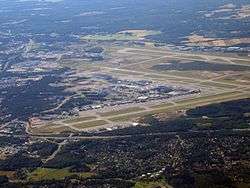Helsinki Airport
| Helsinki Airport Helsinki-Vantaan lentoasema Helsingfors-Vanda flygplats | |||||||||||||||||||
|---|---|---|---|---|---|---|---|---|---|---|---|---|---|---|---|---|---|---|---|
 | |||||||||||||||||||
|
Aerial view of Helsinki Airport | |||||||||||||||||||
| IATA: HEL – ICAO: EFHK | |||||||||||||||||||
| Summary | |||||||||||||||||||
| Airport type | Public | ||||||||||||||||||
| Operator | Finavia | ||||||||||||||||||
| Serves | Helsinki, Finland | ||||||||||||||||||
| Location | Vantaa | ||||||||||||||||||
| Opened | 1952 | ||||||||||||||||||
| Hub for |
| ||||||||||||||||||
| Focus city for | |||||||||||||||||||
| Elevation AMSL | 55 m / 179 ft | ||||||||||||||||||
| Coordinates | 60°19′02″N 024°57′48″E / 60.31722°N 24.96333°ECoordinates: 60°19′02″N 024°57′48″E / 60.31722°N 24.96333°E | ||||||||||||||||||
| Website |
www | ||||||||||||||||||
| Map | |||||||||||||||||||
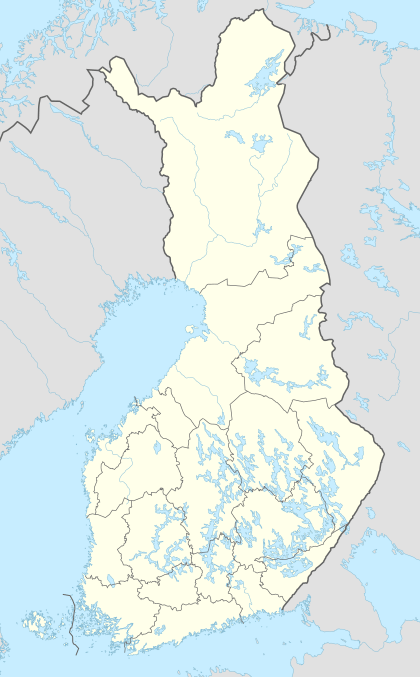 HEL Location within Finland | |||||||||||||||||||
| Runways | |||||||||||||||||||
| |||||||||||||||||||
| Statistics (2015) | |||||||||||||||||||
| |||||||||||||||||||
Helsinki Airport[4] or Helsinki-Vantaa Airport[5] (IATA: HEL, ICAO: EFHK; Finnish: Helsinki-Vantaan lentoasema, Swedish: Helsingfors-Vanda flygplats) is the main international airport of the Helsinki metropolitan region. The airport is located in the city of Vantaa, about 5 kilometres (3 mi) west of Tikkurila, the administrative centre of Vantaa and 9.2 NM (17.0 km; 10.6 mi) north[2] of Helsinki city center. The airport is operated by Finavia. Helsinki Airport is the leading long-haul airport in Northern Europe.[6]
The airport is the main international gateway to Finland and the biggest airport in the country. It is the 31st largest airport in Europe and 4th largest in the Nordic countries in terms of passenger numbers. About 90% of Finland’s international air traffic passes through Helsinki Airport.[7] The airport handled 16.4 million passengers in 2015, including 13.8 million international passengers and 2.6 million domestic passengers. The airport handled 165,430 tonnes of cargo in 2015. On average, the airport handles around 350 departures a day.[7]
The airport is the main hub for Finnair, the flag carrier of Finland, and its subsidiary Nordic Regional Airlines. It is also the hub for CityJet (on behalf of SAS), Jet Time, TUIfly Nordic and operating base for Norwegian Air Shuttle and Primera Air. The airport is also a focus city for Thomas Cook Airlines Scandinavia. Helsinki Airport handles around 40 airlines, including 28 scheduled and 13 charter airlines, while offering scheduled and charter flights to over 130 destinations in 45 countries worldwide. The airport offers a total of 21 direct long-haul routes to Asia and North America and numerous long-haul charter destinations.[8] Currently Helsinki Airport has two terminals with a total of 27 jet bridges and numerous remote parking stands.
Overview
Originally built for the 1952 Summer Olympics in Helsinki, the airport is today the fourth busiest airport in the Nordic countries,[9] with 16,422,266 passengers having used the airport in 2015. This number makes up for around 90% of the total number of passengers in Finland's 21 commercial airports combined (around 20 million) making it the busiest airport in Finland by far. It provides jobs for 20,000 people and there are 1,500 companies that operate at this airport.[10] The airport is operated by Finavia, the state-owned enterprise that operates Finland's airports.
As of February 2015, there has been a proposal to rename the airport as "Sibelius Airport" after Jean Sibelius, Finland's most famous composer. The proposal stems from the project group of Jean Sibelius's anniversary year 2015, the foundation for the Sibelius birth city foundation and the Sibelius society. The Finnish government ministers Alexander Stubb, Antti Rinne and Paula Risikko have expressed positive feedback for the proposal.[11][12]
History
Opening and early years
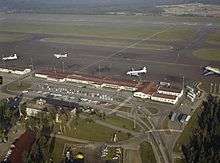
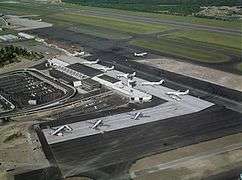
Plans for a new airport at Helsinki had begun as early as the 1940s, when it had become evident that the old airport at Malmi could not handle the increasing number of passengers or the new, heavier aircraft.[13]
Helsinki Airport was originally built for the 1952 Summer Olympics in Helsinki. The first two Aero Oy DC-3 aircraft, OH-LCC and OH-LCD, landed on 26 June 1952. While Aero (now Finnair) used Helsinki-Malmi Airport, charter flights were directed to the new airport on 26 October 1952. The airport originally had a single runway, the second runway being built four years later in 1956. Regular jet flight operations began in 1959. The year 1973 saw the first security checks being carried out for international flights. A new terminal opened in 1969, while the first transatlantic service to New York was inaugurated on 15 May 1969.
1970s–1990s
The name Helsinki-Vantaa Airport was taken in use in 1977. In 1983, the airport began offering the first non-stop service from Western Europe to Japan as Finnair commenced regular service between Helsinki and Tokyo with a single McDonnell Douglas DC-10-30ER. The passenger terminal was expanded for the first time in 1983 and five years later, in 1988, the airport handled over six million passengers annually. A new terminal was constructed for domestic flights in 1993. In 1996 the international terminal was expanded and merged with the domestic terminal. At the same time, the new control tower was completed. In November 1999, the international terminal was further expanded and the lobby for arriving and departing passengers was built.
2000s–2010s
In 2000, the airport handled over 10 million passengers for the first time in its history. The third runway was inaugurated on 28 November 2002. Its first user was a Finnair McDonnell Douglas MD-11 en route to New York. In 2004, the international terminal was again expanded and a new shopping area was opened for long-haul passengers. In 2009, the latest expansion of Terminal 2 was completed. The total floor area was 43,908 square metres (472,620 sq ft). The same year witnessed the opening of a new shopping area and spa for passengers on long-haul flights, the removal of a terminal-specific division between domestic and international flights, and the renovation of Terminal 1 for international flights. In July 2015, train operation on the Ring Rail Line and connection to Helsinki Central Railway Station were opened.
Airline history
In the 1990s, Delta Air Lines commenced its operations at the airport and also another American carrier, Pan Am, operated flights from Helsinki to the US. In 2009, TAP Portugal commenced service between Helsinki and Lisbon. In April 2010, Norwegian Air Shuttle opened its first routes to Oslo and Stockholm using Boeing 737 jets.[14] Now the airline is the one of the largest operators at the airport. As of 2008, easyJet had operated three routes from Helsinki to Manchester, London-Gatwick and Paris-Charles de Gaulle. However the low-cost carrier cancelled these routes in 2011, citing weak demand at the Helsinki end of the routes.[15] In May 2011, American Airlines opened summer seasonal service between Helsinki and Chicago, United States using Boeing 767 jetliners.[16] However, the airline cancelled service in 2014 as the route was converted to Finnair. In November 2011, Austrian Airlines cancelled its Vienna-Helsinki operations. In 2012, Helsinki Airport got its another daily service to Tokyo as Japan Airlines commenced service to Helsinki using Boeing 787 Dreamliners. In the same year, Czech Airlines ceased its Helsinki operations due to low demand. A year later, LOT Polish Airlines cancelled its service to Helsinki. In 2014, a number of airlines cancelled their operations. In that year Aer Lingus and Germanwings as well as S7 Airlines and Wizz Air that also started operations in that year, cancelled services to Helsinki. In March 2015, Swiss International Air Lines started operations to Helsinki but cancelled it a year after and thus Finnair is the only airline to operate service between Helsinki and Switzerland. In late 2015, Blue1 ceased all operations from Helsinki, its only base. The airline flew to around 28 destinations in Europe. Scandinavian Airlines sold Blue1 to CityJet, which continues to operate the company on behalf of SAS as part of a larger relationship.[17] In March 2016, Czech Airlines resumed flights from Prague to Helsinki using Airbus A319, Boeing 737-400 and Boeing 737-700 aircraft. On 10 October 2016, the first Gulf carrier Qatar Airways commenced operations at the airport.
Composition
Terminals
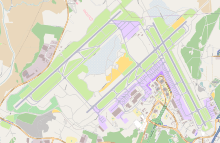
The airport is nominally divided into two terminals, located 250 metres (820 ft) apart and linked by an internal pedestrian connection both airside and landside. In practice, however, the airside parts of the terminal buildings are not divided into Terminal 1 (the former domestic terminal) and Terminal 2 (the former international terminal) but to Schengen and non-Schengen areas. The terminal capacity of the airport is approximately 16–17 million passengers per year.[18]
Domestic flights as well as flights to European Schengen countries are operated from gates 11–31. Long-haul and European non-Schengen flights are operated from gates 31–38.[19]
In 2014, Helsinki airport introduced the world's first passenger tracking system,[20] which automatically monitors crowd congestion and prevents bottlenecks at the two-terminal airport.[20]
Terminal 1
Terminal 1 (gates 5–15) has 11 gates of which four are equipped with jet bridges. The terminal opened in 1952 and is the first terminal at the airport. It is used by Star Alliance carriers, such as Aegean Airlines, Lufthansa, Scandinavian Airlines, and TAP Portugal. In addition to Star Alliance members, airBaltic and Vueling also operate flights from this terminal. Previously, Icelandair operated its services to Reykjavík from this terminal but moved to Terminal 2 on 13 April 2015.[21] Currently, no carriers operate long-haul flights from Terminal 1. The terminal has a train connection to Helsinki Central railway station.
Terminal 1 passenger facilities include tax-free shops, free wireless Internet access, power sockets, and lockers. There are also several restaurants, cafés and the SAS Business Lounge.[22]
-
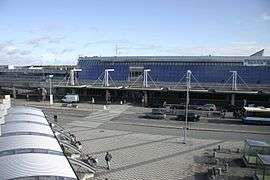
The exterior of Terminal 1
-
Café in Terminal 1
-
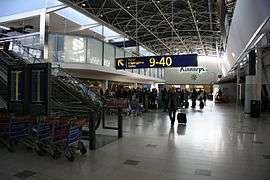
The interior of Terminal 1
-
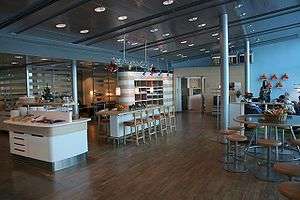
SAS Business Lounge
Terminal 2
Terminal 2 (gates 16–38) opened in 1969 for international operations and, at present, also serves domestic flights. It is the largest of the two passenger terminals at the airport. All intercontinental flights operate from Terminal 2. The non-Schengen area of Terminal 2 has been enlarged in 2009 enabling the airport to accommodate eight wide-body aircraft at gates simultaneously while a new shopping area and a spa were opened for passengers on long-distance flights and the division between domestic and international flights was removed. Terminal 2 has many restaurants, bars and shopping areas. The terminal is equipped with 26 aircraft parking stands with passenger bridges. The terminal has a train connection to Helsinki Central railway station.
Terminal 2 passenger facilities include: numerous tax-free shops, Avis, Europcar and Hertz-car rentals, free wireless Internet access, power sockets, lockers, sleeping pods and transfer service desks. Currency exchange, cash machines (ATM), tourist information, an Alepa grocery store and pharmacy are also available. For children, there are also several playrooms. Dining facilities include Burger King and O'Learys Sports Bar as well as numerous other restaurants and cafés. Terminal 2 also includes two Finnair lounges: Finnair Lounge in the Schengen-area and Finnair Premium Lounge in the non-Schengen area.
Terminal 2 is used by member airlines of Oneworld and Skyteam airline alliances. Turkish Airlines makes an exception among Star Alliance airlines by using Terminal 2. In addition to the scheduled services listed, almost all charter flights are handled at Terminal 2. The current airlines using Terminal 2 are Aeroflot, Air Berlin, Airest, Arkia, Belavia, British Airways, Budapest Aircraft Service, Corendon Airlines, Czech Airlines, Finnair, Finnair operated by Nordic Regional Airlines, Freebird Airlines, Jet Time, Icelandair, Japan Airlines, KLM, Nextjet, Norwegian Air Shuttle, Nouvelair Tunisie, Onur Air, Primera Air Scandinavia, Qatar Airways, Sun Express, Thomas Cook Airlines Scandinavia, TUIfly, TUIfly Nordic, TUIfly Nordic operated by Thomson Airways, Turkish Airlines, Ukraine International Airlines and Ural Airlines. In addition to current airlines, Terminal 2 will have a fourth airline to serve long-haul flights as Beijing Capital Airlines starts flights from Beijing in May 2017.[23]
-
The exterior of Terminal 2
-
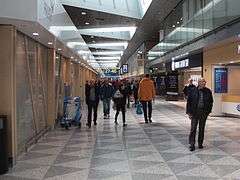
The interior of Terminal 2
-
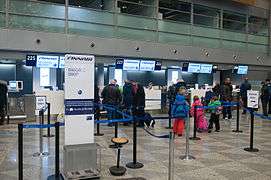
Finnair's check-in area
-

Terminal 2 in 1969
Other buildings
There are several airport hotels and office buildings on the grounds of the airport. The Aviapolis is a new international business park adjacent to the Helsinki airport area, already hosting the operations of numerous companies around the airport. In 2013, Finnair opened its new head office, known as House of Travel and Transportation (or "HOTT"). The construction of HOTT began in July 2011 and finished on time in June 2013.
Facilities
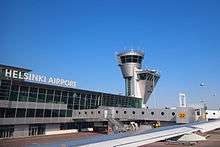
Cargo facilities
.jpg)
Helsinki Airport has extensive cargo flight activity. There is a cargo area with cargo terminals and cargo transit facilities in the southeastern part of the airport area. ASL Airlines Belgium (formerly TNT Airways) and DHL have their own cargo terminals at the airport. At the airport there is a new cargo terminal under construction for Finnair Cargo that is the largest operator for passenger and cargo operations at the airport. Currently scheduled cargo operating airlines are AirBridgeCargo Airlines operated with Boeing 747 cargo aircraft, ASL Airlines Belgium, DHL Aviation operated by EAT Leipzig and IAG Cargo and FedEx, UPS Airlines. Turkish Airlines operates its cargo services to HEL with Airbus A310 and A330 cargo aircraft (sometimes operated by ULS Airlines Cargo and MASkargo). In addition to scheduled cargo operations many other cargo airlines such as Emirates SkyCargo, Kalitta Air and Lufthansa Cargo have random operations at Helsinki Airport.
Ground handling
The following handling agents provide ground handling services for airlines:[24] Airpro, Aviator and Swissport.
Runways
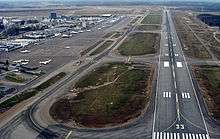
Helsinki Airport has three runways: Runway 1 (04R/22L), Runway 2 (04L/22R) and Runway 3 (15/33). Runway 1 is 3,500 metres (11,483 ft), Runway 2 is 3,060 metres (10,039 ft) long and Runway 3 is 2,901 metres (9,518 ft) long. The runways can handle take-offs and landings of the heaviest aircraft in use today such as Airbus A380. The airport's three runways provide a platform for future growth while the airport is capable of accommodating wide-body aircraft. The use of three runways allows two runways to be kept open when clearing of snow and ice is needed (if one runway at a time is being cleared).[25]
Principles of using runways
There are about twenty different runway combinations in use. The primary runway for landings is Runway 2 (15) from northwest, i.e. from the direction of Nurmijärvi, or Runway 1 (22L) from northeast, i.e. from the direction of Kerava, while the primary runway for take-offs is Runway 3 (22R) towards southwest, in the direction of Western Vantaa and Espoo. Aircraft with low noise can take off from Runway 1 (22L) towards the south at the same time. When the wind is from the north or east, Runway 3 (04L) or Runway 1 (04R) are usually used for landings, i.e. for approaches from south-west, the direction of Western Vantaa and Espoo, while take-offs are made from Runway 1 (04R) towards northeast in the direction of Kerava. At night-time, landings are primarily made using Runway 2 (15) from northwest, i.e. from the direction of Nurmijärvi, and take-offs using Runway 3 (22R) towards southwest, in the direction of Espoo. Jet plane landings to Runway 2 (33) from the southeast and take-offs from Runway 2 (15) towards the southeast are avoided due to dense population in the affected areas. At night-time, propeller plane operations towards the southeast are also prohibited unless otherwise dictated by air traffic safety. Air traffic safety is the main reason for not always being able to choose the optimal runway for noise control.[26]
Air traffic
The following airlines maintain hub or base operations at Helsinki Airport:
- Finnair is the largest airline operating at the airport, with an all-Airbus fleet of over 57 aircraft based at Helsinki, providing scheduled services to the Middle East, Asia, Europe and North-America. Finnair operates almost 20 intercontinental routes from HEL. All flights are operated from Terminal 2.
- Jet Time is a charter airline that operates several flights from Helsinki to Europe.
- Nordic Regional Airlines, a subsidiary of Finnair that operates from Helsinki to Europe with its ATR and Embraer fleet. This airline operates from Terminal 2
- Norwegian Air Shuttle, a low-cost airline which operates to over 30 destinations from Helsinki to Europe and the Middle East. It operates from Terminal 2.
- Thomas Cook Scandinavia Airlines uses Helsinki Airport as a focus city with many charter flights to Asia and Europe. The airline operates from Terminal 2.
- TUIfly Nordic, a charter airline that operates to Asia, Europe and North-America. The airline operates from Terminal 2.
Future development
Master Plan 2020
Development timeline
In 2013 Finavia announced plans to expand the airport to serve up to 20 million passengers by 2020. The construction is set to begin in 2014 by adding capacity to check-in and transit areas at Terminal 2. The expansion project is estimated to cost 900 million euros. Among the completed and planned projects are:[27]
Completed projects
- Renewal of Baggage Claim Hall 2B (Completed as of January 2015)
- Renovation of Arrival Hall 2A (Completed as of June 2015)
- Train connection (Completed as of July 2015)
- Renovation of Runway 1 (Completed as of August 2015)
- 3,000 new parking spaces (Completed as of August 2016)
- New aircraft engine test site (Completed as of October 2016)
Planned projects
- Finnair's new cargo terminal (March 2017)
- The new southern wing (August 2017)
- The new western wing (Summer 2020)
Expansion of Terminal 2
Part of the plan was to build a satellite terminal next to Terminal 2 but the plan was cancelled in favor of expansion under a single terminal building.[28] In September 2014 Finavia revealed more detailed plans for the future expansion that will take place between 2014 and 2020. Terminals 1 and 2 will be combined and expanded under one roof with new gates (8 additional gates to Terminal 2) and aircraft stands on the apron.[29] All gates for long-haul flights will have double jet bridges (such as the ones at Incheon International Airport) to enable handling larger aircraft more efficiently. Finavia has made a contract with Thyssen Krupp Airport Systems for 16 wide-body aircraft stands with up to 33 new jet bridges. Gate 49 will be able to accommodate the Airbus A380 superjumbo and there will be new aircraft stands on the apron accommodating the A380. Five of the gates will be able to accommodate two regional jets, such as Boeing 737s or Airbus A320s, simultaneously at a single gate.[30] The terminal will have Finland's first moving walkways.
On 20 September 2016, the construction on the west wing begun, even though it was expected to start in 2017. The construction of the west wing is expected to be finished in 2020. The west wing represents some EUR 300 million of Finavia’s substantial total investment of EUR 900 million. The first part of the west wing to be built is the large central plaza, which is scheduled to open in late 2018. It will bring 25,000 square metres (270,000 sq ft) of new passenger and baggage facilities to the airport.[31]
The Helsinki Airport development programme also includes plans to expand Terminal 2 to the area currently used for parking and public transport. This would provide more space for check-in, security control and baggage operations, allowing the airport to concentrate all departure and arrival services to a single terminal.[31]
Construction of the southern wing of Terminal 2 started on 4 January 2016.[32] Once the southern wing is completed in summer 2017, the floor area of the terminal will increase by a total of 7,850 square metres (84,500 sq ft). There will be two floors: one for arriving passengers, the other for departures. The area of the apron to be renovated covers a total of 157,000 square metres (1,690,000 sq ft).
New cargo terminal
The construction of a new freight terminal (35,000 m2 or 380,000 sq ft) began in March 2015. The capacity of the terminal is being expanded to accommodate the growing freight capacity that will be provided by Finnair's Airbus A350 XWB fleet. Finnair's freight operations will continue in the current location until relocation to the new freight terminal in spring 2017.[33]
Planned third terminal
In addition to the terminal expansion, Finavia has also contemplated building a third terminal at Helsinki Airport. According to Finavia's tentative plan, the new terminal would be located between runways 04R/22L and 04L/22R, while runway 15/33 would be removed. The terminal would be the principal terminal at the airport but the check-in area would stay in the current terminal building. The decision to build the third terminal has not been done yet.[34]
Airlines and destinations
Passenger
Helsinki Airport offers scheduled and charter flights to over 150 destinations in 50 countries around the world. The following airlines offer scheduled flights at Helsinki Airport:[35]
- Notes
^1 Some flights operated by Danish Air Transport.
Charter
Cargo
- Notes
^2 Some flights operated by MASkargo or ULS Airlines Cargo.
Statistics
Busiest routes
.jpg)
.jpg)
.jpg)
.jpg)
.jpg)
.jpg)
.jpg)
10 busiest European routes by weekly departures:
| Rank | City | Airport(s) | Weekly departures (May 2014) |
Airlines |
|---|---|---|---|---|
| 1. | |
ARN, BMA | | |
| 2. | |
CPH | | |
| 3. | |
LHR, LGW | | |
| 4. | |
RIX | | |
| 5. | |
OSL | | |
| 6. | |
FRA | | |
| 7. | |
TLL | | |
| 8. | |
CDG, ORY | | |
| 8. | |
TXL | | |
| 10. | |
MUC | | |
| 10. | |
AMS | | |
10 busiest intercontinental scheduled routes by weekly departures:
| Rank | City | Airport(s) | Weekly departures (January 2016) |
Airlines |
|---|---|---|---|---|
| 1. | |
Tokyo - Narita | | |
| 2. | |
Bangkok - Suvarnabhumi | | |
| 3. | |
Dubai - International | | |
| 4. | |
Beijing - Capital | | |
| 5. | |
Hong Kong | | |
| 6. | |
New York - JFK | | |
| 7. | |
Seoul - Incheon | | |
| 8. | |
Shanghai - Pudong | | |
| 9. | |
Singapore | | |
| 10. | |
Delhi | | |
10 busiest domestic routes by weekly departures:
| Rank | City | Airport(s) | Weekly Departures (May 2014) |
Airlines |
|---|---|---|---|---|
| 1. | |
OUL | | |
| 2. | |
KUO | | |
| 3. | |
VAA | | |
| 4. | |
RVN | | |
| 5. | |
TMP | | |
| 5. | |
TKU | | |
| 7. | |
JOE | | |
| 8. | |
KAJ | | |
| 9. | |
JYV | | |
| 10. | |
KEM | | |
Countries with most handled passengers
to/from Helsinki Airport (2015)
| Rank | Country | Passengers | |
|---|---|---|---|
| 1. | |
1,693,436 | |
| 2. | |
1,658,409 | |
| 3. | |
1,366,811 | |
| 4. | |
1,144,734 | |
| 5. | |
787,370 | |
| 6. | |
589,589 | |
| 7. | |
557,679 | |
| 8. | |
556,839 | |
| 9. | |
553,617 | |
| 10. | |
522,309 | |
| 11. | |
403,317 | |
| 12. | |
402,592 | |
| 13. | |
393,248 | |
| 14. | |
344,378 | |
| 15. | |
332,512 | |
| 16. | |
328,144 | |
| 17. | |
270,604 | |
| 18. | |
240,702 | |
| 19. | |
233,183 | |
| 20. | |
231,370 | |
| 21. | |
221,466 | |
| 22. | |
218,400 | |
| 23. | |
185,084 | |
| 24. | |
176,171 | |
| 25. | |
172,427 | |
| 26. | |
168,917 | |
| 27. | |
140,752 | |
| 28. | |
125,270 | |
| 29. | |
112,419 | |
| 30. | |
109,617 | |
| "Traffic statistics – Scheduled traffic" (PDF). Finavia. | |||
Airline market share
| Rank | Airline | Share |
|---|---|---|
| 1 | Finnair1 | 67.1% |
| 2 | Norwegian Air Shuttle | 12.5% |
| 3 | Scandinavian Airlines | 5.4% |
| 4 | Lufthansa | 3.4% |
| 5 | KLM | 1.6% |
| 6 | Air Berlin | 1.6% |
| 7 | Turkish Airlines | 1.5% |
| 8 | airBaltic | 1.3% |
| Other airlines | 5.5% | |
- Notes
- ^1 Includes Nordic Regional Airlines
Passengers
| |
passengers |
|
passengers |
|
passengers |
|
|---|---|---|---|---|---|---|
| 2016 (YTD) |
2,175,906 | 3.2 | 12,324,379 | 4.5 | 14,500,285 | 4.3 |
| 2015 | 2,591,724 | 3.4 | 13,830,542 | 2.9 | 16,442,266 | 3.0 |
| 2014 | 2,507,193 | 3.1 | 13,441,567 | 4.6 | 15,948,760 | 4.4 |
| 2013 | 2,431,632 | 10.8 | 12,847,411 | 5.6 | 15,279,043 | 2.8 |
| 2012 | 2,693,151 | 0.5 | 12,165,064 | 0.0 | 14,858,215 | 0.1 |
| 2011 | 2,707,044 | 22.6 | 12,158,827 | 14.6 | 14,865,871 | 15.5 |
| 2010 | 2,208,521 | 9.6 | 10,674,878 | 4.3 | 12,883,399 | 2.2 |
| 2009 | 2,372,844 | 12.1 | 10,218,762 | 4.9 | 12,591,606 | 6.3 |
| 2008 | 2,700,350 | 6.1 | 10,726,551 | 4.5 | 13,426,901 | 2.2 |
| 2007 | 2,875,289 | 1.8 | 10,215,455 | 10.8 | 13,090,744 | 7.8 |
| 2006 | 2,927,627 | 4.4 | 9,220,154 | 10.7 | 12,147,781 | 9.1 |
| 2005 | 2,804,304 | 1.1 | 8,326,285 | 5.5 | 11,130,589 | 3.7 |
| 2004 | 2,836,852 | | 7,893,125 | | 10,729,977 | 10.5 |
| 2003 | 2,684,618 | | 7,026,302 | | 9,710,920 | 1.1 |
| 2002 | 2,747,862 | | 6,862,025 | | 9,609,887 | 4.2 |
| 2001 | 2,999,672 | | 7,031,246 | | 10,030,918 | 0.2 |
| 2000 | 3,042,914 | | 6,967,234 | | 10,010,148 | 4.7 |
| 1999 | 2,803,907 | | 6,760,931 | | 9,564,028 | 2.2 |
Freight and Mail
| Year | Domestic freight | Domestic mail | International freight | International mail | Total freight and mail | Change |
|---|---|---|---|---|---|---|
| 2005 | 4,692 | 5,251 | 115,734 | 9,627 | 135,303 | +1.9% |
| 2006 | 4,145 | 5,469 | 126,332 | 9,098 | 145,044 | +7.2% |
| 2007 | 3,171 | 5,676 | 139,840 | 14,961 | 154,801 | +6.7% |
| 2008 | 2,968 | 4,435 | 140,572 | 9,532 | 157,508 | +1.8% |
| 2009 | 1,322 | 2,161 | 110,382 | 8,243 | 122,107 | −22.5% |
| 2010 | 1,083 | 1,992 | 147,139 | 7,793 | 158,007 | +29.4% |
| 2011 | 615 | 2,464 | 157,178 | 9,962 | 169,985 | +8.0% |
| 2012 | 1,747 | 1,930 | 180,426 | 8,100 | 192,204 | +12.8% |
| 2013 | 1,260 | 1,857 | 179,615 | 7,713 | 190,175 | -1.0% |
| 2014 | 987 | 1,558 | 175,341 | 10,986 | 188,872 | -0.7% |
| 2015 | 598 | 1,378 | 150,366 | 9,185 | 161,572 | -14.7% |
Ground transportation
Rail
Helsinki Airport rail services | |
|---|---|
Legend
|
The Ring Rail Line railway link to the airport opened for traffic in July 2015.[55] The new railway serves local commuter trains running at 10-minute intervals at peak periods, although capacity problems have prevented dedicated airport express style trains. The westbound commuter line "I" runs to Helsinki Central station via Huopalahti, while the eastbound commuter line "P" runs to Helsinki Central station via Tikkurila. The trip from the airport underground station to Helsinki Central station takes about 30 minutes and costs 5,50 euros. Eastbound trains stop at Tikkurila (8 minutes away) where passengers can transfer to trains going away from Helsinki, in the directions of Tampere and Lahti, including lines to Saint Petersburg and Moscow.[56]
Taxi
Taxi ranks are located outside Terminal 1 and Terminal 2.[57]
Bus
There is regular bus service provided by the bus line 615 from the airport to the Helsinki Central railway station in 30–55 minutes, and major hotels and railway stations in the Greater Helsinki Area in 15–120 minutes. The chief operator of these services is the Helsinki Regional Transport Authority. A direct coach service by Finnair is also available to and from the city center (usually about 30 min). On 1 June 2016, the new bus terminal opened. It is located between Terminal 2 and Hilton-hotel.[58]
Coach connections, daytime and overnight, to all parts of Finland are provided by Matkahuolto and ExpressBus. They depart from the airport coach terminal.
| Means of transport | Operator | Route | Destinations | Website | Notes | ||
|---|---|---|---|---|---|---|---|
| Helsinki Regional Transport Authority | 615 | Helsinki Central railway station (Finnish: Rautatientori) | www.hsl.fi | ||||
| Pohjolan Liikenne | Finnair City Bus | Helsinki Central railway station | www.pohjolanliikenne.fi | ||||
| Matkahuolto | -- | Hämeenlinna, Imatra, Joensuu, Jyväskylä, Kajaani, Kotka, Kouvola, Kuopio, Lahti, Lappeenranta, Lohja, Mikkeli, Oulu, Porvoo, Salo, Tampere, Turku, Vaasa | www.matkahuolto.fi | ||||
| OnniBus.com | OnniFlyer (F10) | Naantali, Raisio, Turku, Salo | onniflyer.com | ||||
| VR | P | Helsinki Central railway station (via Tikkurila railway station) | www.vr.fi | ||||
| VR | I | Helsinki Central railway station (via Huopalahti railway station) | www.vr.fi | ||||
See also
References
- ↑ "CityJet to Fly New Aircraft For SAS". Dublin: CityJet DAC. 1 October 2015. Retrieved 25 September 2016.
- 1 2 "EFHK Helsinki-Vantaa" (PDF). AIP Suomi / Finland. Finavia. 23 July 2015. pp. EFHK AD 2.1, pp. 1–7. Retrieved 25 July 2015.
- ↑ "Finavia's Air Traffic Statistics 2010" (PDF). Vantaa: Finavia. pp. 7, 9. Retrieved 15 July 2011.
- ↑ "Helsinki Airport". Finavia. Retrieved 29 August 2014.
- ↑ "EFHK Helsinki-Vantaa" (PDF). AIP Suomi / Finland. Finavia. 5 February 2015. pp. EFHK AD 2.1, p. 1. Retrieved 18 July 2015.
- ↑ "(HEL) Helsinki-Vantaa Airport". Retrieved 10 May 2015.
- ↑ "Helsinki Airport". www.helsinkiairport.net (unofficial website). Retrieved 10 May 2015.
- ↑ Sirén, Vesa (4 February 2015). "Arvovaltainen aloite: Helsinki-Vantaan lentokentästä Sibelius-lentokenttä". Helsingin Sanomat (in Finnish). Retrieved 25 September 2016.
- ↑ "Helsinki-Vantaan lentoaseman nimeen halutaan Jean Sibelius". MTV Uutiset (in Finnish). MTV Oy. 4 February 2015. Retrieved 10 May 2015.
- ↑ "Norwegian alkaa lentää Yhdysvaltoihin ja Aasiaan". Taloussanomat (in Finnish). Helsinki: Sanoma Media Finland Oy. 28 June 2010. Retrieved 25 September 2016.
- ↑ "easyJet finishes with Finland; three Helsinki routes to end in June/July; Blue1 and Norwegian adding UK routes". anna.aero. 23 March 2011. Retrieved 25 September 2016.
- ↑ "American Airlines Lentää Helsingistä Chicagoon" (in Finnish). American Airlines. Retrieved 25 September 2016.
- ↑ "SAS Enters into Agreements with Cityjet for Wet Lease and Sale of Blue1". Business Wire. 1 October 2015. Retrieved 25 September 2016.
- ↑ http://www.helsinki-vantaa.fi/enemman-tietoa/helsinki-vantaa-lyhyesti/kehityshankkeet/terminaalilaajennus
- ↑ "Terminals".
- 1 2 "Helsinki airport introduces world's first passenger tracking system". The Sydney Morning Herald. 30 July 2014. Retrieved 30 July 2014.
- ↑ "Services".
- ↑ Ge, Lena (22 April 2016). "Capital Airlines Plans Mexico City, Zagreb, Helsinki Flights". China Aviation Daily. Retrieved 25 September 2016.
- ↑
- ↑ "How Helsinki airport deals with snow and ice". BBC News. 20 December 2010. Retrieved 16 July 2011.
- ↑ "Runway use, Helsinki Airport".
- ↑ "ThyssenKrupp toimittaa Helsinki-Vantaan uudet matkustajasillat". Lentoposti.fi (in Finnish). 12 August 2016. Retrieved 25 September 2016.
- ↑ Juntunen, Esa (4 August 2013). "Finavia havittelee Helsinki-Vantaalle uutta terminaalia". Helsingin Sanomat (in Finnish). Retrieved 25 September 2016.
- ↑ "Helsinki Vantaa on ch-aviation".
- ↑ 2016, UBM (UK) Ltd. "Finnair suspends Chongqing service Jan - Apr 2017".
- 1 2 "Summer 2017: Finnair opens new routes to San Francisco and Alicante". Finnair Plc. 22 September 2016. Retrieved 25 September 2016.
- ↑ "Finnair". 3 November 2016.
- ↑ Liu, Jim (19 August 2016). "Finnair plans new European routes in S17". Routesonline. Manchester: UBM (UK) Ltd. Retrieved 25 September 2016.
- 1 2 "Summer 2017: Finnair announces new routes to Reykjavik, Corfu, Menorca and Ibiza; increases capacity to UK and Ireland". 4-Traders. 18 August 2016. Retrieved 25 September 2016.
- ↑ "Flights to Menorca". Finnair Plc. Retrieved 25 September 2016.
- ↑ "Finnair avaa yhteyden Reykjavikiin kesällä 2017 – muita uusia kohteita ovat Korfu, Menorca ja Ibiza". Lentoposti.fi (in Finnish). 18 August 2016. Retrieved 25 September 2016.
- ↑ Liu, Jim (23 August 2016). "Finnair schedules Kaunas seasonal flights in S17". Routesonline. Manchester: UBM (UK) Ltd. Retrieved 23 August 2016.
- ↑ "Puerto Naos".
- 1 2 3 4 5 "Thomson Airways Schedules Boeing 787-9 W16 Nordic Operations". Routesonline. Manchester: UBM (UK) Ltd. 30 May 2016. Retrieved 25 September 2016.
- ↑ 2016, UBM (UK) Ltd. "Transavia expands Netherlands operation in S17".
- ↑ 2016, UBM (UK) Ltd. "Transavia adds new routes from Munich in S17".
- 1 2 3 4 "Helsinki-Vantaalle palaava Pullmantur lennättää Suomeen kesällä lähes 2500 risteilymatkustajaa - lentoposti.fi". 10 June 2016.
- ↑ 2016, UBM (UK) Ltd. "Royal Jordanian schedules Aqaba W16 European charter flights".
- ↑
- ↑ "Finnair's A350 delivery brings more growth to Helsinki-Vantaa Airport. Now to attract other airlines - CAPA - Centre for Aviation".
- ↑ "Kehärata avautuu kuun vaihteessa – lentoasemalle pääsee junalla vasta pari viikkoa myöhemmin".
- ↑ "Ring Rail Line". Finnish Transport Agency. 14 July 2011. Retrieved 16 July 2011.
- ↑ "Helsinki Airport - Ground Transport (How to arrive)".
- ↑ "Helsinki-Vantaalle avautui uusi bussiporttiterminaali - kuljetusten tarve kasvaa laajennustöiden ajaksi - lentoposti.fi". 2 June 2016.
External links
![]() Media related to Helsinki-Vantaa Airport at Wikimedia Commons
Media related to Helsinki-Vantaa Airport at Wikimedia Commons
- Official website
- AIP Finland – Helsinki-Vantaa Airport
- Accident history for HEL at Aviation Safety Network
